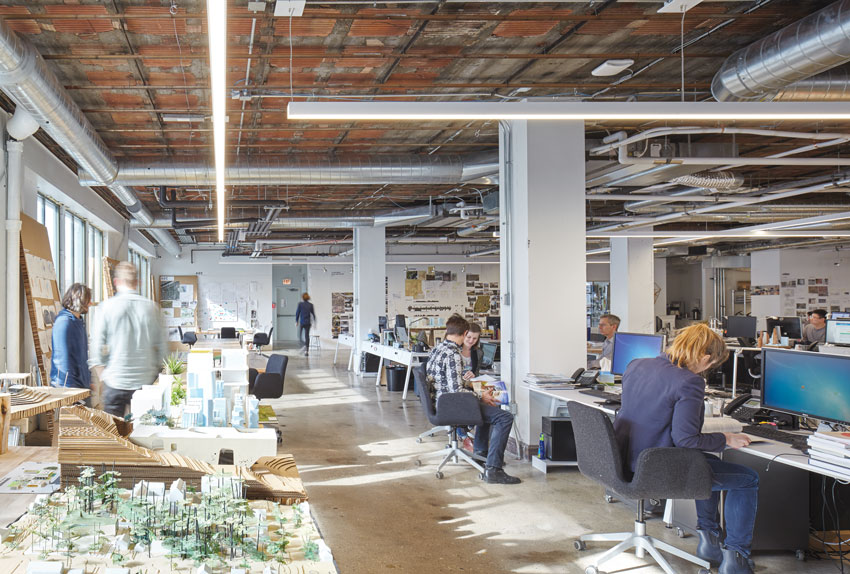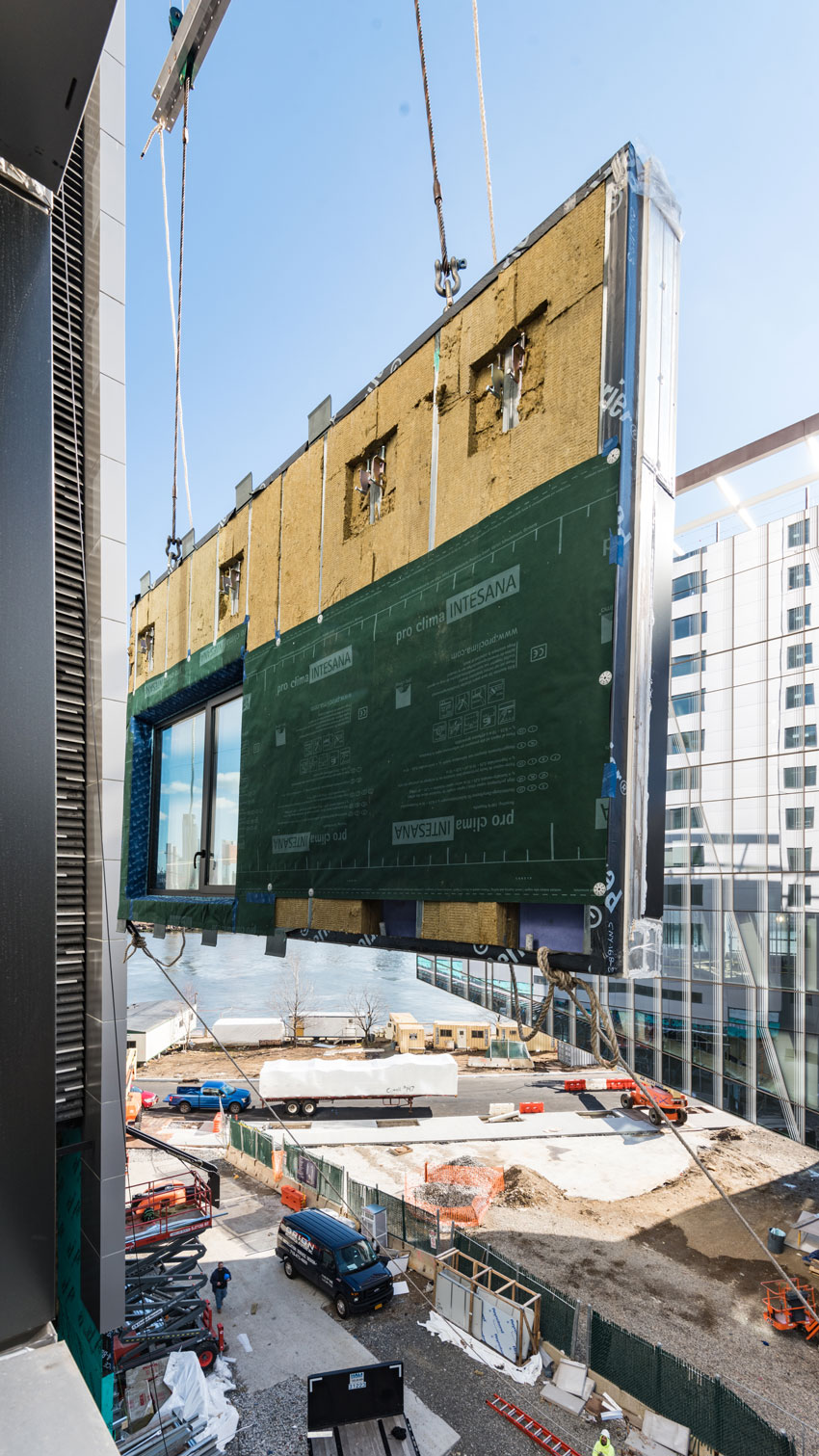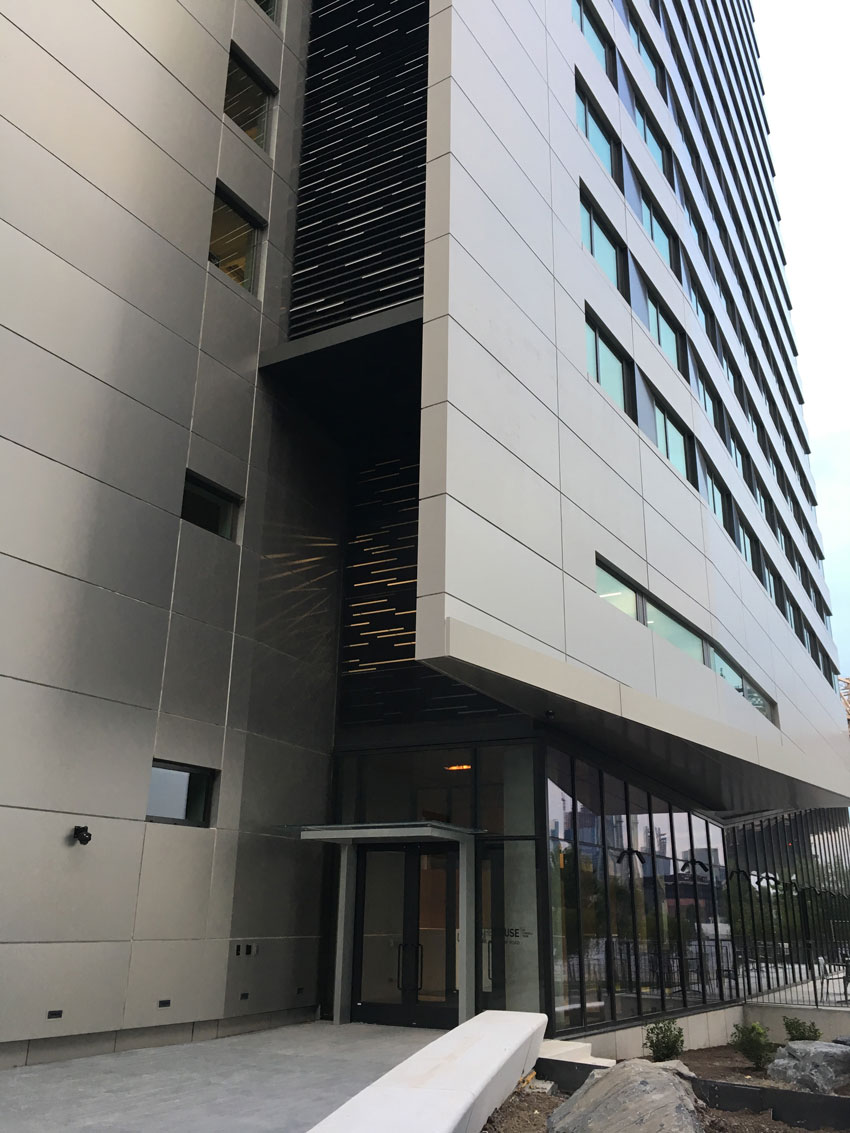Sustainability Without Compromise
The HVAC System that Delivers Comfort and Energy Savings with Minimal Footprint
The VRF HVAC system used in the Studio Gang Chicago office building delivered comfort and energy savings within a small enough footprint to enable the historical building to achieve Landmark status. When looking to specify a system that can provide this combination of benefits, seek a VRF HVAC solution that incorporates an inverter-driven compressor technology, is capable of heat recovery, and uses a two-pipe configuration that can simultaneously cool and heat different areas within a building. Here is a little more information about a VRF system and how it differs from the traditional HVAC solution.

Photo courtesy of Mitsubishi Electric Cooling & Heating
VRF HVAC solutions require smaller runs of ductwork to distribute the conditioned air, dramatically reducing the necessary footprint of the system.
Introducing the VRF System
Traditional commercial HVAC systems inefficiently move conditioned air or water throughout a building. Not only does it require a lot of energy to move that air or water, but those mediums are challenged to provide precise temperature control. A variable refrigerant flow (VRF) system moves conditioned refrigerant directly to the zone to be cooled or heated, conditioning the air within the space and delivering precise and efficient comfort control. Many systems also provide the ability to simultaneously cool some zones while heating others or to limit conditioning to only zones that are in use.
“Traditional cooling and heating systems require tremendous energy to force air from a central blower to a room through a complex system of ductwork, which uses space in buildings and wastes energy. With VRF systems, installation time and costs are reduced, building occupants are comfortable, and energy bills are lower,” explains Kevin Miskewicz, director of commercial marketing, Mitsubishi Electric Trane HVAC US.
Inverter-Driven Compressor
In HVAC terminology, the compressor is the engine driving the HVAC system. In traditional HVAC systems, the compressor speed is constant. It can be on or off. In a VRF system, an inverter-driven compressor controls the speed of the system and can vary the speed depending upon the HVAC needs of the building. The variability of the compressor motor speed can create incredible energy savings.
Heat Recovery
An HVAC system that is capable of heat recovery takes the heat extracted from zones that require cooling and uses it in zones that require heat. This repurposing of available heat allows for better thermal performance across different zones and contributes toward the impressive energy efficiencies created across these systems. It is important to note that VRF systems capable of heat recovery can simultaneously cool and heat different zones within a building.
Small and Simple Refrigerant Piping
VRF HVAC systems distribute refrigerant to the area of the building that needs it, conditioning air locally, rather than conditioning air in a central area and then distributing the conditioned air throughout the building. This essentially flips the structure of the system as well. Instead of pulling one run of refrigerant piping from the outside unit to a central location and having bulky ductwork traipse throughout the building to deliver conditioned air, VRF HVAC systems feature more runs of the smaller refrigerant piping pulled to different areas of the building and shorter runs of smaller, low-profile ductwork to deliver the conditioned air into the immediate space, making the footprint of these systems much smaller and easier to design around.

Photo courtesy of Mitsubishi Electric Cooling & Heating
The use of a VRF HVAC system in the Studio Gang Chicago office created a comfortable interior that reduced energy use by more than $600 per month.
Two-Pipe System Format
A VRF system is available as either a two-pipe or three-pipe system. The two-pipe solution dramatically reduces the total amount of refrigerant piping needed for the project, making design and installation easier and less expensive. In terms of functionality, there are two-pipe systems that can simultaneously heat and cool interior areas. A two-pipe system capable of heating and cooling simultaneously was selected for the Studio Gang Chicago office space.
Adoption of VRF Systems Worldwide
The technology is gaining popularity in the United States due to its ability to deliver an incredible combination of benefits, enabling designers to achieve aggressive energy performance and interior comfort goals. The system’s small footprint makes it easier to incorporate into new construction as well as existing buildings.
The Stone Wool Insulation Creating High-Performance Envelopes
Insulation is an important component of a high-performance, sustainable building. In creating the envelope of the Passive House-certified project The House at Cornell Tech, designers created continuous insulation free from the thermal bridges that compromise thermal performance, essentially wrapping the building in an insulated blanket. In order to accomplish this, designers used stone wool insulation in various products and forms.

Photo courtesy of Handel Architects
Various forms of stone wool insulation were used inside the building envelope of The House at Cornell Tech to surpass the aggressive thermal performance criteria of the Passive House standard.
Introducing Stone Wool Insulation
Stone wool insulation is made of melted stone and recycled materials that are spun into a wool. Stone wool insulation brings the natural strengths of stone into the envelope and interior of a building. This sustainable material is inherently fire resistant, mold and mildew resistant, and absorbs sound, supporting the design of safe and sustainable buildings in many different ways.
Available for Exterior and Interior Application
There are several stone wool insulation products that have been developed to meet the specific needs of various exterior wall systems, such as rainscreen, cavity wall, exterior continuous insulation, curtain wall, and wood-frame and metal-frame constructions. These stone wool solutions are fully compatible with a very diverse array of building components and claddings, enabling designers to create beautiful and creative high-performance building envelopes. Stone wool insulation products are also available for internal and separation wall applications.
Create Continuous Insulation
Continuous insulation is defined by ASHRAE 90.1 as “insulation that is continuous across all structural members without thermal bridges other than fasteners and service openings. It is installed on the interior, exterior, or is integral to any opaque surface of the building.” When built correctly, continuous insulation creates a super-insulated building envelope that can also help to achieve NFPA 285 compliance and aggressive performance and sustainability targets. The variety of stone wool insulation products ensures that designers have the tools to create continuous insulation in numerous applications.
Additional Benefits
Stone wool insulation products can provide many significant benefits to the building, the occupants, and the environment, truly embodying the spirit of sustainable design. Regardless of project or application, there are high-quality stone wool insulation solutions that enhance building performance by improving energy efficiency and occupant comfort, while providing moisture management, vapor permanence, fire safety, and acoustical control that contribute toward satisfying green building criteria.

High-quality stone wool insulation solutions also improve the ability of the building envelope to provide moisture management, vapor permanence, fire safety, and acoustical control.
Notice

www.guardianglass.com

MitsubishiPro.com

www.rockwool.com

www.waclighting.com









